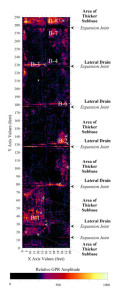Challenge
Engineers observed with concern significant outflow of water from beneath the base of the concrete spillway of the earthen dam at Lincoln State Park near Santa Claus, Indiana. Observations of flow patterns over the spillway indicate that water may be flowing through voids beneath the slabs, potentially resulting in erosional damage to the subbase. Although the concrete slabs of the spillway were level and unbroken, the purpose of the study was to locate voids before any damage occurred. In order to keep project costs to a minimum, the project engineer commissioned a geophysical investigation to map the location of potential voids below the concrete using non-destructive means. Identified voids underneath the spillway were to be remediated with grout pumped into the subbase of the concrete.
Technical Approach
Based on the project objectives, a high-resolution ground penetrating radar (GPR) survey was recommended to image the concrete and potential voids. Mundell has found that three-dimensional time-slice amplitude mapping is a rapid and cost-effective method to process and analyze very large GPR datasets such as this one. This method is used to composite a grid of vertical GPR profiles into a three-dimensional model that can be sliced horizontally to produce a map of the GPR response over any user-defined depth interval.
Results
After processing and analyzing the composited average amplitude GPR response at various depth slices, the 1.20 to 2.00 feet depth interval map was selected as most relevant to the project objectives (see Figure). Test borings of the high amplitude anomalies on this map (B-1 through B-7) indicated areas of thicker subbase materials as well a system of lateral sub concrete drains installed in anticipation of water flow beneath the spillway. The GPR investigation revealed the source of the outflow from beneath the slabs and verified that the subbase materials were sound.




